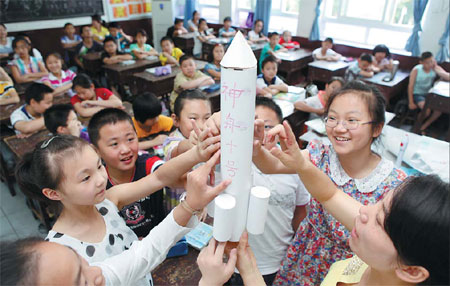Astronauts into space module
Updated: 2013-06-14 08:12
By Xin Dingding (China Daily)
|
||||||||
|
Primary students in Chongqing display their hand-made model of the Shenzhou X spacecraft on Thursday. Chen Shichuan / for China Daily |

Successful automatic docking reported by Beijing control center
The three Shenzhou X astronauts moved into the Tiangong-1 space module on Thursday following a successful automatic docking.
The spacecraft completed the docking procedure at 1:18 pm, according to the Beijing Aerospace Control Center.
It is the fifth docking between a Shenzhou spacecraft and the unmanned space module conducted by China.
The control center said Shenzhou X, launched on Tuesday from the Jiuquan Satellite Launch Center in Gansu province, began to approach the Tiangong-1 automatically at 10:48 am, making contact with it at 1:11 pm.
The astronauts, sitting in the spacecraft's re-entry capsule, monitored and reported the docking operation to the control center.
After the two spacecraft were locked together and the space module was checked, astronaut Nie Haisheng opened the doors leading to Tiangong-1 with help from fellow astronaut Zhang Xiaoguang.
The three astronauts, clad in blue spacesuits, then floated into the module one by one. They later waved to a camera in the module.
In coming days they will live in the space module, carrying out scientific and technical experiments and giving a lecture to students on Earth, Wu Ping, spokeswoman for the program, said.
There will also be a manual docking between Shenzhou X and the module, although Wu did not give a date for this.
The mission is expected to help scientists verify and improve space rendezvous and docking technology, crucial for assembling an orbiting space station.
Space rendezvous and docking is a technically difficult procedure, with both vessels moving at 28,000 kilometers per hour during the docking, making the maneuver highly risky.
Jiao Weixin,a space scientist at Peking University, said space rendezvous and docking is hard to master. "It is like asking two racing cars to keep a distance of 1 meter between them."
Two automatic dockings between the unmanned Shenzhou VIII and Tiangong-1 were conducted in 2011, and an automatic and manual docking took place between the manned Shenzhou IX and the space module in 2012.
The successful missions saw China become the third country to master the technology, following the United States and Russia.
After the Shenzhou X mission, China will enter the space lab stage, the final stage before it builds a space station around the year 2020.
Qi Faren, former chief designer of the Shenzhou spacecraft, said China needs to master four vital technologies in order to launch the space station.
So far, it has learned how to carry out extravehicular activity, and acquired the space rendezvous and docking technology thanks to the previous missions.
Solving a supply problem and recycling air and water in the space lab for astronauts on long-duration missions remain to be tackled.
Zhou Jianping, chief designer of the manned space program, said in March the Tiangong-2 space lab will be launched in two years, followed by the launch of a space freighter.
The freighter will conduct a fueling experiment with the space lab, which is expected to solve the supply problem.
xindingding@chinadaily.com.cn
(China Daily USA 06/14/2013 page3)

 Michelle lays roses at site along Berlin Wall
Michelle lays roses at site along Berlin Wall
 Historic space lecture in Tiangong-1 commences
Historic space lecture in Tiangong-1 commences
 'Sopranos' Star James Gandolfini dead at 51
'Sopranos' Star James Gandolfini dead at 51
 UN: Number of refugees hits 18-year high
UN: Number of refugees hits 18-year high
 Slide: Jet exercises from aircraft carrier
Slide: Jet exercises from aircraft carrier
 Talks establish fishery hotline
Talks establish fishery hotline
 Foreign buyers eye Chinese drones
Foreign buyers eye Chinese drones
 UN chief hails China's peacekeepers
UN chief hails China's peacekeepers
Most Viewed
Editor's Picks

|

|

|

|

|

|
Today's Top News
Shenzhou X astronaut gives lecture today
US told to reassess duties on Chinese paper
Chinese seek greater share of satellite market
Russia rejects Obama's nuke cut proposal
US immigration bill sees Senate breakthrough
Brazilian cities revoke fare hikes
Moody's warns on China's local govt debt
Air quality in major cities drops in May
US Weekly

|

|








